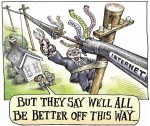The FCC and a large portion of the nation are wringing our collective hands about net neutrality. But the real issue is not “neutrality” but “affordability” and even “accessibility”. Clearly the future of the Nation depends upon the Internet, but a large portion of households and small businesses can’t afford Internet access at true broadband speeds. And, as cool new applications such as high-definition video develop, the gaps will only widen, and even more Americans will be left in the dust of the Net. Net Neutrality doesn’t mean much if you can’t afford a connection in the first place.
First of all, let’s recognize that providing Internet or broadband is not a competitive, market-driven business. It is a closely held, almost unregulated, monopoly (actually duopoly). Most areas of the United States have very little choice for Internet service providers. You can get DSL or dial-up from Ma Bell (the phone company), or you can get Internet from Ma Cable (the cable company). In a few places you can get Ma Wireless (Clear or Clearwire, also peddled by Sprint-Nextel).
Essentially this is a duopoly – Ma Bell and Ma Cable. And they make sure they don’t “really” compete – they keep prices high to keep profits high from their existing ancient outmoded copper cable networks. And they do everything they can to make the profit larger. You want more channels? You want HDTV? You want an extra modem or cable box? You want faster speeds? In every case, you pony up more bucks. Besides the certainty of death and taxes, there is the certainty your cable bill will rise 5% to 7% or more, year in, year out.
And where do those profits go? To create faster networks or fiber cable networks to help the United States dig our way out of the being in 15th place worldwide for broadband penetration? Hardly, Comcast wants to buy NBC so they will control not only the network, but more of the content flowing across it as well. No wonder Consumerist magazine rates Comcast the most hated company in America. But most cable companies are equally disliked.
Net neutrality is important. When most of the nation has very little choice in Internet providers, and those few providers want to maximize profits, they will be tempted to charge content providers for access. In other words, they might decide to charge Google so its search engine has priority for most users, and other search engines (e.g. Microsoft’s Bing) are slower. Or perhaps Fox’s, ABC’s, and CBS’s web sites will work a bit slower compared to NBC, which pays (or is owned by) an network provider to get priority access to the network. Worse yet, individual users who are on the leading edge, developing web content or Internet applications, may be using a lot of bandwidth. Ma Bell or Ma Cable are already deciding to cap the usage of such users, or charge THEM for priority access. This will stifle innovation. This is happening today, e.g. Frontier in Minnesota and cable companies across the U. S.
The FCC is addressing network neutrality, and is likely to take some action. I spoke on an FCC net neutrality panel in Seattle on April 28th. Most of the panelists supported FCC action to keep the network neutral. My presentation is here.
The real problem, however, is network accessibility and affordability.
The City of Seattle – and other cities and counties – can regulate cable TV to a limited extent. Therefore we can demand cable companies provide a low cost basic service – $12.55 in Seattle for Comcast, for example, and there’s even a discount to that low rate for low-income residents – more details here.
The State of Washington – and other States – can regulate telephone service, and require telephone companies to provide a low cost basic phone rate, e.g. $8 a month for 167,000 households.
But NO ONE regulates broadband/Internet access. Consequently ISPs can charge whatever the market will bear. So in our present monopoly or duopoly environment throughout the nation – that is little choice for most of us – prices are at $30, $40 or more for even moderate speed access. Higher speed access is $100 or more. And that means low-income, immigrant, seniors and other households cannot afford access to the Internet. So they and their children are denied what is probably the most important pathway to education, information, jobs and higher income – access to the Internet. Even middle income households or neighborhood businesses cannot get affordable truly fast (e.g. 5 megabits per second symmetric) broadband.
Elsewhere in the world, homes and businesses and get much higher Internet speeds at much lower costs. France and Japan, for example, have much lower prices than the US for really high speed broadband.
This is an economic development issue, it is making the United States competitive with the rest of the world for innovation in technology, it is a race and social justice issue.
The FCC, in the national broadband plan, has set a bold goal to bring 100 million households a broadband speed of 100 million bits per second by 2020. That’s a remarkable vision, and with active intervention by the FCC, network neutrality on that high speed network will be in place. But, in our nation with the Internet controlled by just a few providers, can such high speed networks really be constructed, and will the Internet access be affordable?
I think not.




